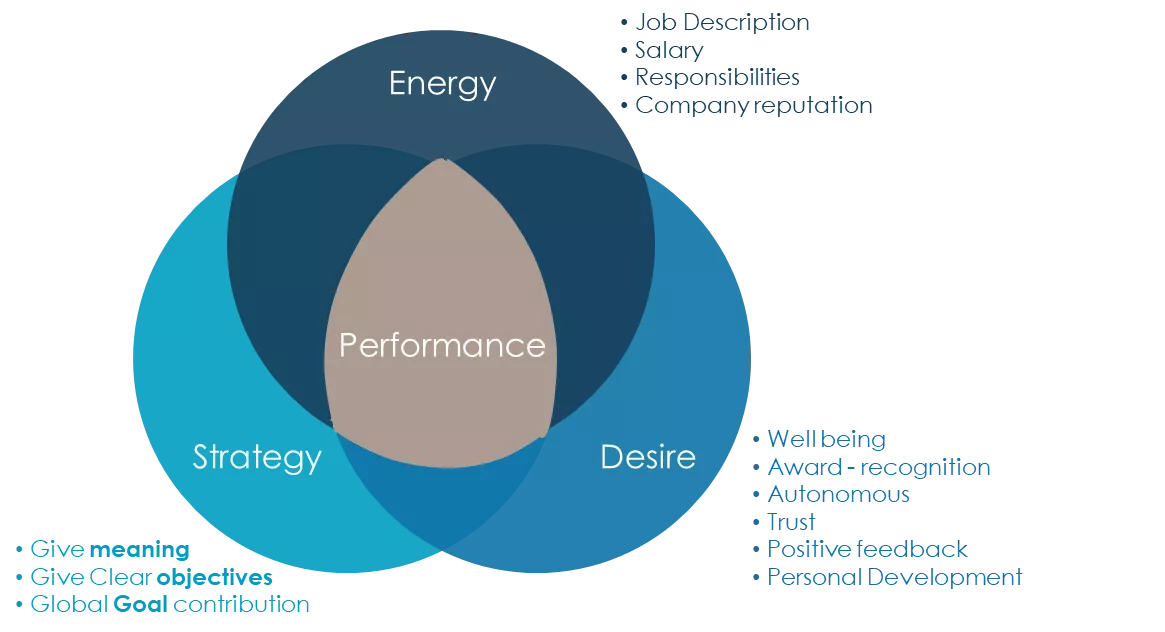Energy drives the world. All that exists needs energy, which makes everything efficient. Energy is powerful enough to create one’s success or accelerate his or her downfall. Everything you involve yourself in is a result of the energy you contribute.
Do you jump out of bed every morning because you feel that your life has a purpose and that you make an impact? Does purpose and impact energize you and keep you motivated? If yes, then you should read on.
When there are positive attitudes in a workplace, it feels like everything can be accomplished. Colleagues support each other and work in tandem, and a host of other positive outcomes will materialize. As a leader, your energy can determine the success of a meeting, a workday or even your overall company.
This positive energy creator concept is based on three axes: ENERGY, DESIRE and STRATEGY

Each axis has to be developed, improved and deployed across the organization to achieve good team PERFORMANCE and to keep talents in the company. There are different incentives to attract talented employees. Attracting talents is one thing but keeping them is another matter. It is, however, essential to keep in mind that the new generation is less attached to their company and their profession than the former generation.
The new big challenge for companies is the management of the Z generation.
Let’s compare the different generations:
Generation X:
this generation is critical for institutions and other generations, seeks work-life balance, needs recognition and participates in decision-making. This generation likes to learn and grow.
Generation Y:
this generation is unable to grasp the concept of punctuality, courtesy, etc..., and tends to seek work-life-fun balance. Individuals from this generation do not blindly obey their superiors and need reasons to do carry out tasks. They like to be involved in decision-making and prefer to be coached and mentored. Another characteristic of the individuals from generation Y is that they show great adaptability as they have been through events in their personal lives that oblige them to adapt (divorce, integration into a stepfamily as examples). Members of generation Y are used to crises therefore money is not taboo, since they do not have much to begin with. Young members of generation Y tend to live with their parents for a long time. For them, authenticity and transparency are important, not empty words.
Generation Z:
this generation is an extension of generation Y. Individuals from this generation are thought to be resourceful, pragmatic, self-taught, passionate, entrepreneurial and outward-looking. Young members of generation Z may behave in a way that challenges traditional values and appear insolent. They do not see the need to separate their work life and personal life.
The phenomenon of the Z generation spreads to the previous generations. Most workers yearn for work-life balance and personal development. This aspect has to be taken into consideration by organizations, in order to manage the right balance for employees.
Human capital is the heart of a company and collaborative intelligence is the key to increase success of a team. Collective intelligence is defined by collective determination to reach an identical objective through knowledge sharing and learning.
There are many ways to change the mindset of a company regarding added value thanks to innovative approaches and solutions:
- Support change initiatives to meet objectives on time and on budget by increasing employee’s ownership and usage
- Train and coach senior managers on change Management and new leadership behaviors
- Define and deploy a team charter on Quality Culture and Knowledge
- Support the definition and deployment of a Knowledge Management (KM) culture via a KM network
- Disseminate a positive mindset thanks to appropriate behaviors and point of views
- Coach-mentor of key resources on workshop facilitation, communication and human performance understanding
- Support stakeholder management from director to shop floor workers.
There are many ways to improve the capabilities of workers through optimizing the learning practices and the philosophy of continuous improvement. Some examples are:
- Propose innovative approaches to improve the quality and efficiency of training (micro learning; virtual reality; adult learning)
- Support the improvement of quality culture and knowledge management
- Develop training material (e-learning and Instruction Lead training) on human factors for blue-collar workers, first line leaders and managers
- Coordinate the leverage capabilities of the trainers
- Organize the development of soft skills and coaching teams, when needed.
Companies are faced with uncertainties in a fast-paced dynamic world and they want to (re)create trust in the future. They are looking for balance between high productivity and workplace satisfaction.
People are the greatest asset of a company. There are tools available to help build the future, to turn managers into leaders, resources into motivated business makers, and clients into partners. The challenge is to build bridges between people and projects. To develop today’s innovative solutions, sellers and doers have to work side-by-side. A sustainable, end-to-end business solution can only be achieved by reconciling these two.
To improve company performance, create positive energy and, not the least, a better work environment, concepts, tools, and trainings can be created and developed. Everybody is unique. Everybody has added value. One does not have to know everything. Nobody is essential, but everyone is necessary. If you are able to and know how to help – then help.
